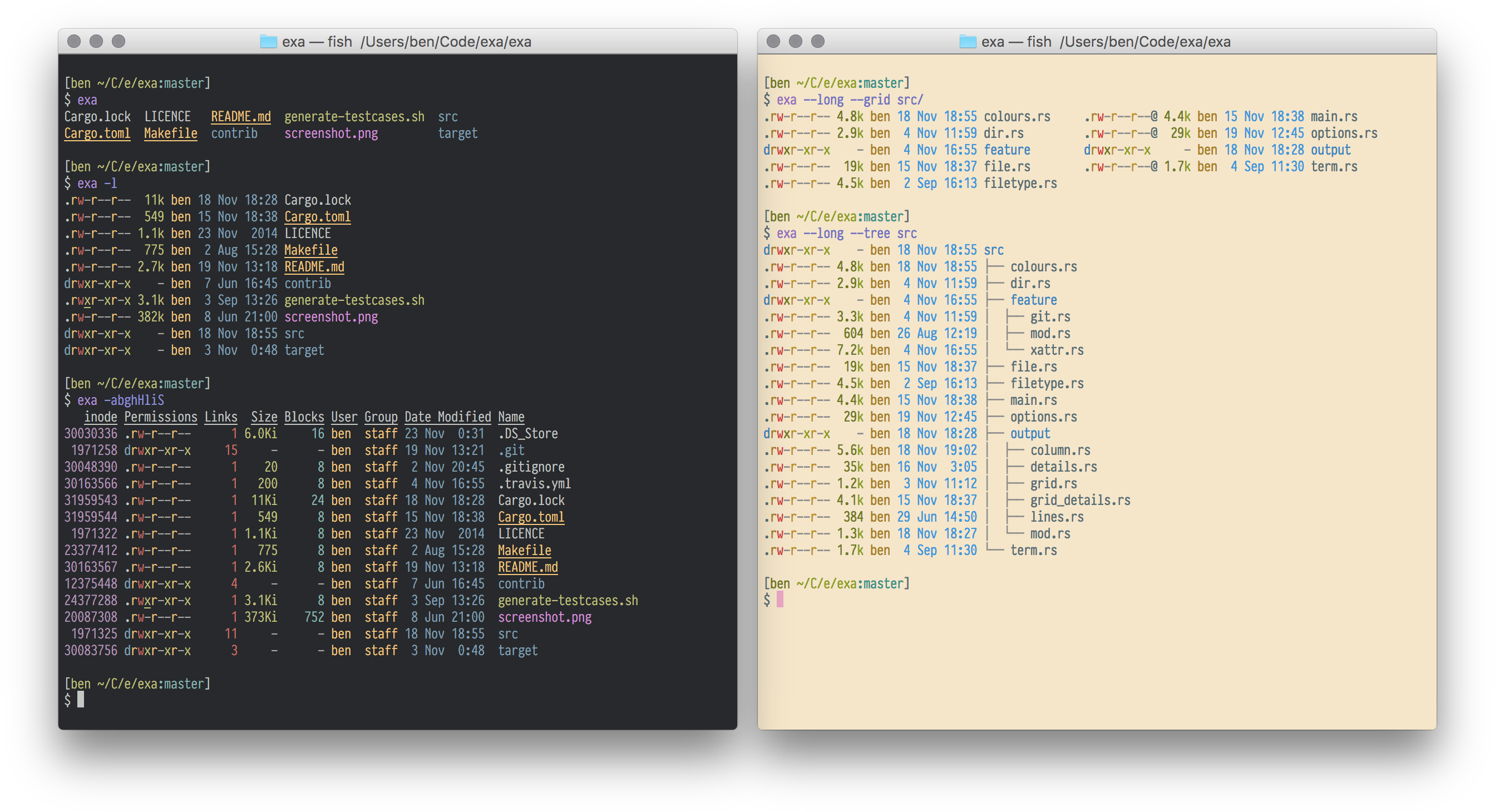Why I have to keep doing this I have no idea. If you know, please tell!
exa 
exa is a replacement for ls written in Rust.
Screenshots
Options
exa’s options are almost, but not quite, entirely unlike ls's.
Display Options
- -1, --oneline: display one entry per line
- -G, --grid: display entries as a grid (default)
- -l, --long: display extended details and attributes
- -R, --recurse: recurse into directories
- -T, --tree: recurse into directories as a tree
- -x, --across: sort the grid across, rather than downwards
- --colo[u]r: when to use terminal colours
- --colo[u]r-scale: highlight levels of file sizes distinctly
Filtering Options
- -a, --all: show hidden and 'dot' files
- -d, --list-dirs: list directories like regular files
- -L, --level=(depth): limit the depth of recursion
- -r, --reverse: reverse the sort order
- -s, --sort=(field): which field to sort by
- --group-directories-first: list directories before other files
- --git-ignore: ignore files mentioned in
.gitignore - -I, --ignore-glob=(globs): glob patterns (pipe-separated) of files to ignore
Pass the --all option twice to also show the . and .. directories.
Long View Options
These options are available when running with --long (-l):
-
-b, --binary: list file sizes with binary prefixes
-
-B, --bytes: list file sizes in bytes, without any prefixes
-
-g, --group: list each file's group
-
-h, --header: add a header row to each column
-
-H, --links: list each file's number of hard links
-
-i, --inode: list each file's inode number
-
-m, --modified: use the modified timestamp field
-
-S, --blocks: list each file's number of file system blocks
-
-t, --time=(field): which timestamp field to use
-
-u, --accessed: use the accessed timestamp field
-
-U, --created: use the created timestamp field
-
-@, --extended: list each file's extended attributes and sizes
-
--git: list each file's Git status, if tracked
-
--time-style: how to format timestamps
-
Valid --color options are always, automatic, and never.
-
Valid sort fields are accessed, created, extension, Extension, inode, modified, name, Name, size, type, and none. Fields starting with a capital letter sort uppercase before lowercase. The modified field has the aliases date, time, and newest, while its reverse has the aliases age and oldest.
-
Valid time fields are modified, accessed, and created.
-
Valid time styles are default, iso, long-iso, and full-iso.
Installation
exa is written in Rust. You will need rustc version 1.17.0 or higher. The recommended way to install Rust is from the official download page.
Once you have it set up, a simple make install will compile exa and install it into /usr/local/bin.
exa depends on libgit2 for certain features.
If you’re unable to compile libgit2, you can opt out of Git support by running cargo build --release --no-default-features.
Cargo Install
If you’re using a recent version of Cargo (0.5.0 or higher), you can use the cargo install command:
cargo install exa
or:
cargo install --no-default-features exa
Cargo will build the exa binary and place it in $HOME/.cargo (this location can be overridden by setting the --root option).
Homebrew
If you're using homebrew, you can use the brew install command:
brew install exa
or:
brew install exa --without-git
Testing with Vagrant
exa uses Vagrant to configure virtual machines for testing.
Programs such as exa that are basically interfaces to the system are notoriously difficult to test. Although the internal components have unit tests, it’s impossible to do a complete end-to-end test without mandating the current user’s name, the time zone, the locale, and directory structure to test. (And yes, these tests are worth doing. I have missed an edge case on more than one occasion.)
The initial attempt to solve the problem was just to create a directory of “awkward” test cases, run exa on it, and make sure it produced the correct output. But even this output would change if, say, the user’s locale formats dates in a different way. These can be mocked inside the code, but at the cost of making that code more complicated to read and understand.
An alternative solution is to fake everything: create a virtual machine with a known state and run the tests on that. This is what Vagrant does. Although it takes a while to download and set up, it gives everyone the same development environment to test for any obvious regressions.
First, initialise the VM:
host$ vagrant up
The first command downloads the virtual machine image, and then runs our provisioning script, which installs Rust, exa’s dependencies, configures the environment, and generates some awkward files and folders to use as test cases. This takes some time, but it does write to output occasionally. Once this is done, you can SSH in, and build and test:
host$ vagrant ssh
vm$ cd /vagrant
vm$ cargo build
vm$ ./xtests/run
All the tests passed!
Running without Vagrant
Of course, the drawback of having a standard development environment is that you stop noticing bugs that occur outside of it. For this reason, Vagrant isn’t a necessary development step — it’s there if you’d like to use it, but exa still gets used and tested on other platforms. It can still be built and compiled on any target triple that it supports, VM or no VM, with cargo build and cargo test.
